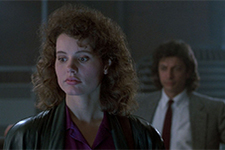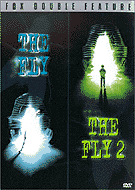The Fly (1986)
|  Near the middle of David Cronenberg's “The Fly,” the main character, abrilliant scientist named Seth Brundle (Jeff Goldblum), declares, “You can't penetratebeyond society's sick, grave fear of the flesh.” That statement essentially summarizes the cinematic career of David Cronenberg.Throughout all his films, from his early horror movies like “The Brood” (1979) to hishighly controversial adaptation of J.G. Ballard's “Crash” (1996), his central aim has alwaysbeen penetrating the fear we have of our own bodies by distorting them. As Steven Shavironoted in his excellent book, “The Cinematic Body,” “David Cronenberg's films focusinsistently, obsessively on the body.... They are unsparingly visceral; that is what makesthem so disturbing.” In the history of cinema, there has been no filmmaker more adept at making us feel uneasyabout our own bodies than Cronenberg. His entire oeuvre (especially his early films) is acatalog of human grotesquerie, mutation, and biological horror. In “Shivers” (1975), aparasite invades a high-tech apartment building and turns its inhabitants into libidinalzombies, which has often been read as a metaphor for venereal disease. In “Rabid” (1977),an ordinary woman becomes a vampiric creature after plastic surgery, and in “Videodrome”(1982) the human body finds its ultimate role in becoming the servant of video technology,the literal merging of the flesh and the mechanical. Yet, Cronenberg does not detest the body, as film scholar Robin Wood has argued, and hisprimary aim is not simply to drive his audience to revulsion, a point that has been made byPauline Kael. Instead, these extreme examples of biological horror are simply a means ofmaking his audience face and deal with their physical bodily existence. The fact that hisfilms cause such unease is testament to his filmmaking abilities and the way in which theytap into preexisting fears. In terms of generating unease about our own bodies, Cronenberg's real masterpiece is his1986 film “The Fly,” which is a loose remake of the late '50s cult classic in which ascientist finds himself with the head and arm of a housefly after an experiment with ateleportation device goes terribly wrong. Cronenberg and co-screenwriter Charles EdwardPogue maintain this basic scenario, but they twist it by having the effects of beinggenetically combined with a fly emerge gradually, like a degenerative disease. When Brundle first emerges from his great invention, a teleportation device that breaksdown an object in one pod and then reassembles it in another, he thinks that the machinehas somehow improved him. Full of energy and vigor and with strength and agility he hasnever known before, he lives briefly under the delusion that he has become superhuman. That delusion quickly fades once his exterior begins to break down. Lesions appear on hisface, his fingernails start to fall off, and strange, wiry hairs grow from his back. Hispersonality changes with his physical mutations, which serves to strengthen the connectionbetween the mind and body; in Cronenberg's films, the mind and body are inextricablylinked, which breaks down traditional (and often reassuring in the times of disease)Cartesian notions of a mind/body split. In Cronenberg's world, when the body is in turmoil,so is the spirit. Brundle's girlfriend, a science journalist named Ronnie (Geena Davis), tries to help him, butthere is nothing that can be done. Like so many bodies in Cronenberg's films, Brundle's isout of control. There is nothing he can do but go through denial before eventually acceptinghis fate: He is becoming Brundlefly, a new life form that has never existed before. To many, “The Fly” is merely another Cronenbergian exercise in being gross. To be sure,the movie is quite sickening in the visceral detail with which Cronenberg documentsBrundle's metamorphosis. Physical change of this magnitude is an ugly thing, andCronenberg's camera never shies away from any of it. Yet, the film is much deeper than its sci-fi/horror surface. The metaphorical possibilitiesinherent in the material have led people to read “The Fly” in many ways, most notably asan allegory about AIDS. This reading can be supported, but I see it in more general terms asanother means by which Cronenberg can make us face our existence as physical creatures.With virtual reality and cyberspace becoming more prevalent, the idea of separatingourselves from our physical bodies is becoming more and more plausible. What Cronenbergpushes is the notion that, no matter what, we always have to return to our flesh. Where other Cronenberg films have collapsed under the heavy weight of their own ideas(despite its many virtues, can anyone actually explain the last 15 minutes of“Videodrome”?), “The Fly” succeeds. Perhaps this is because the idea is more simple, moreprimal. The deterioration of the human body is as primal a concept as there is, and it issomething most everyone has considered, especially those who have been first-handwitness to the many degenerative human diseases that are still incurable. The film also works largely on the performers and their characters. Cronenberg's previousfilms did have particularly likable or identifiable characters, so Goldblum's amiable SethBrundle is something of a standout. Although Brundle's personality changes withpractically every scene, he still maintains his basic humanity, even in the worst situations.This is testament to the fine performance by Goldblum, who is so convincing as a brilliantscientist that he has become typecast in the role (“Jurassic Park,” “Independence Day”).His romantic relationship with Geena Davis' Ronnie is affecting and believable, so whenRonnie is forced to do the unthinkable at the end of the film, it an overwhelminglyemotional, as well as horrific, scene. Cronenberg's film was followed a few years later by an inferior, yet still interesting sequel,“The Fly II”. Directed by Chris Walas, who designed the creatureeffects for the first film, “The Fly II” is a more straightforward horror film that picks upwhere the original left off. Ronnie, pregnant with Brundle's child, dies while giving horriblebirth to what turns out to be a seemingly normal baby. Since the baby was conceived afterBrundle's genetic combination with a fly, there is great expectation that the child will carrythose same characteristics. While “The Fly” concentrated heavily on issues surrounding the human body, “The Fly II”takes a wider view and becomes a cautionary story about runaway capitalistic greed.Similar to the capitalist critique in James Cameron's “Aliens” (1986), “The Fly II”establishes a fictional megacorporation, Bartock, which was mentioned briefly in the firstfilm as the company the financed Brundle's experiments. Bartock is run by its namesake,Mr. Bartock (Lee Richardson), a vicious capitalist predator disguised as a harmless oldbusinessman. Literally deluded by his God complex, Bartock assumes ownership ofMartin, the Brundle child, who grows up under the watchful, uncaring eye of his scientistsand lab technicians without ever seeing the outside world. Things are different for Martin because he grows at an accelerated rate. By the time he isfive years old, he is in the body of a normal 20-year-old. Played by Eric Stoltz, who hadalready played shy, misunderstood teenagers in “Mask” (1985) and “Some Kind ofWonderful” (1987), Martin is a hero not unlike his father. Starting off shy and sociallyinept, once his mutations begin to take over, he changes into a murderous, yet sympatheticvillain. Martin does not need to go through the teleporter to experience genetic mutationinto Brundlefly; it is already written into his genetic code. Hence, it is only a matter oftime. “The Fly II” is actually grosser than the first film, but it also far more clumsy. Walas is amuch better special effects designer than he is a director, and the final third of the film inwhich Martin, as the enormous mutated Brundlefly, stalks the Bartock compoundwrecking havoc and murdering anyone who did him wrong earlier in the film, is an awkwardconcoction of science fiction horror and slasher diatribes. Walas is so intent on grossing outhis audience out that he stages death after death, each other a little more vicious and ineptlyfilmed than the first. At one point, a character's head is crushed by a descending elevator ingratuitous close-up, but the lackluster editing robs the scene of any impact because it isobvious that he had plenty of time to get out of the way. Yet, the movie almost redeems itself in the end by finishing with grand poetic justice forBartock, the immoral businessman. So intent on owning the Brundle genetic mutation inorder to exploit it for his own profits, Bartock eventually finds himself on the worst of thereceiving end. Death is too good for him, and the final shot is a great moment of deservedmisery.
Copyright © 2000 James Kendrick | |||||||||||||||||||||||||||||||||||||||||||||||||||||
Overall Rating: 


 (3.5)
(3.5)


